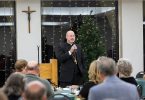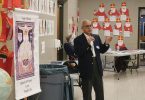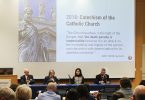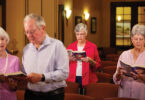
by Olivia Martin
olivia.martin@theleaven.org
LENEXA — Josie squealed and flashed a big smile as her mother Elyssa Bradfield scooped her up and took the pink earrings from her hands.
“What happened?” asked Evan Bradfield, Josie’s father.
“I thought she was about to flush them down the toilet!” said Elyssa.
Luckily, the 20-month-old didn’t make it that far. And the family was able to continue their dinner together without going fishing.
Elyssa, a 7th- and 8th-grade science and religion teacher at St. Ann School in Prairie Village, and Evan, an English teacher at St. James Academy in Lenexa, have been married for three years. And they are pregnant with their second child, a boy.

When The Leaven asked them if they would share their experience as a Catholic mixed race family, they agreed.
But there is an obvious starting point, said Elyssa.
“First and foremost, we are a Catholic family,” she said.
Learning about another
“I grew up in Omaha,” said Elyssa. “My parents moved from Togo when they were in college. I grew up there with a pretty heavy West African influence.”
Evan grew up in Wichita, and both he and Elyssa attended Catholic elementary and high schools.
They met and started dating at Benedictine College in Atchison.
“[Mine] was not an incredibly diverse upbringing,” said Evan.
But as part of his degree at Benedictine, he learned about diversity in a class on race and ethnicity.
And he learned about the history and present reality of racism.
“It was mind-blowing,” he said. “I remember I was sitting on the steps of St. Benedict’s (the parish in Atchison) one night and I was like, ‘Oh my gosh, how do we even move forward in a world so hurt?’”
Evan said this class taught him that there’s a lot of the world he didn’t and maybe would never fully understand — particularly the experience of belonging to a historically oppressed race.
And it helped him assess his preconceptions.
Karen Wood, a sociology professor at Benedictine, taught and continues to teach this course.
“I want [students] to understand the complexities of race and ethnicity,” said Wood, “as well as the ways in which history, language and narrative matter, in that they can affect opportunities and outcomes for certain groups.”
Wood helps students begin to approach race and ethnicity in two ways: by helping them recognize that everyone has preconceived notions or bias; and by learning about others through reading their stories and asking questions.
“There are a lot of people who just don’t know other types of people and they’re biased or prejudiced but don’t realize they are,” said Elyssa. “I think [I’ve experienced] a lot of that in my life, in little things that people would say to reinforce [their bias], not even knowing . . . that it made me feel like I was less than them.
“And I think if they knew they were saying those things, they would feel very upset.”

Because if you hear something often enough, you start to believe it.
“For both my kids, I do have the fear of their self-image, not being confident in who they are or feeling good about themselves in a way they don’t know or understand until it hits them [that it’s because of race],” said Elyssa.
Evan has his worries, too.
“I worry more about the fact that they’ll have experiences that I won’t know how to empathize with, necessarily,” he said. “I think that’s a concern of any parent.
“But the added complexity that they’re half white and half black? That has [not] been insignificant, historically.”
Teaching by witness
Gently educating others about the dignity of all humans, regardless of skin color, is something the Bradfields do simply by living their lives. But they also make themselves available for dialogue.
“When I show pictures of my family to people, and then they see that I have a mixed kid and a black wife . . . I don’t really know what’s being taught,” said Evan. “We are witnesses to the things we believe in.”

For Elyssa, she helps her young students be mindful and respectful of people of other races as the opportunity arises.
“I don’t do lessons on racism,” she said. “But when I hear them saying something, I try to take a moment and . . . [teach them how to speak] about humans as if they’re humans and not just something to laugh at.”
But Evan, teaching at the high school level, can discuss race more directly, particularly through discussions of the literature his students are assigned.
“I think the story of racism in America is something really important to teach and talk about,” he said, “but I find that it’s really difficult to teach.”
As the conversations on race inside and outside of the classroom become more serious and perhaps uncomfortable, they also become more fruitful, said Evan.
“I do think Evan is a really great advocate for people who are different, especially for black people,” said Elyssa. “I always joke that he’s super woke!”
But she also finds Evan a particularly good advocate because he is respectful of those who oppose him.

“He’s not offensive or rude,” she said. “But he does point out that . . . you don’t necessarily know what it’s like on that other spectrum. I think it’s much more meaningful than if I ever say anything, because people assume I’m being sensitive.”
Evan’s approach is not patented, however. This respectful and authentic way of communicating is accessible to everyone.
Anti-racist is the Catholic way
In the face of bias and uncomfortable conversations about race, people can feel helpless.
But there is a way to change for the better: Christ.
“Catholics need to start taking charge in all of these situations,” said Elyssa. “The Catholic Church is the first real social justice warrior — people who see injustice and are upset about it.”
Wood agreed.
“We must combat racism with this kind of gentleness because all of us are in need of having our hearts open to the ‘other’ and we cannot do that with confrontation,” she said.
Wood also shared her gratitude for the presence of African missionaries in the archdiocese — and hopes their presence can be a source of healing and education.

“What a blessing and an opportunity it is for us to have African priests and Sisters in our archdiocese,” she said. “While their experiences are significantly different from black Americans, the beauty of their witness and the joy of their vocations has the potential to open the hearts of American Catholics in the pews in a very gentle and tender way.”
And, ultimately, one thing is clear: It’s the church’s duty to oppose racism — and be a leader in doing so.
“Whether or not it makes you feel uncomfortable, you have to be willing to say something,” said Elyssa. “It’s what we’re called to as Catholics.
“We’re trying to stand for [the essential truth that] everyone is a human being . . . and [that knowledge] helps us better understand who God is.”







Thank you for sharing you story.
BEAUTIFUL STORY. IT ALL STARTS WITH ONE PERSON AT A TIME!